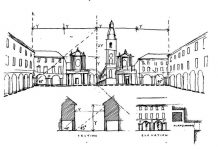It seems that the symmetry method is able to systematize and analyze the perception of a symmetrical object. The process of perception includes several independent levels: the level that provides input of information into the nervous system; the cultural-value level, which reveals analogies, semantic invariants of various cultural phenomena, etc.; the level that provides aesthetic evaluation, etc. At the same time, the “rhythms” of the aesthetic effect of symmetry correlate with the peculiarities of the mental process of visual perception of the object.
It is known that symmetry as a specific doctrine of isomorphism and polymorphism in nature can be applied in the study of specifically different objects, for example, material and ideal. The very idea of such studies consists in abstracting from the qualitative belonging of the studied objects and focusing on the uniform isomorphic parameters of their structure. This feature of the theory of symmetry, in our opinion, is conceptually connected with the fundamental idea of the cultural approach in the theory of art. In relation to symmetry in architecture, this approach is presented as a systematic study of the phenomenon of symmetry in the context of the whole set of ideas of the studied culture: social, aesthetic, ethical, etc. The joint consideration of the subject of research in the field of concrete project experience and in the field outside the experimental spiritual as a subject of artistic activity and as a principle of thinking is an indispensable condition for approaching a comprehensive and, if possible, complete description of symmetry in architecture.
Here, the method of description is a symmetrical comparison, the correlation of visual, graphic and ideal mental realities of different orders in order to detect semantic invariants in the context of ideas, on the one hand, and in the context of three-dimensional forms, on the other. The remark of Yu has a direct relation to the interpretation of the symmetry method . Lotman: “True knowledge consists in identifying isomorphic models for various objects or in establishing infinite variability in the interpretation of these models during the transition from the metalanguage level to the object level.”
In relation to the material of history, the question of the correctness of the symmetry method is natural, about the danger of projecting modern views when describing the facts of the historical past. However, when posing the general problem of the content of the modern concept of symmetry, there is a need to build a certain system or scheme of observation, description and comprehension of facts, research materials, that is, the need to “impose a subjective dependence on the subject of analysis, not to be able to release it from dependence on the subjective understanding state of the researcher.”
The method of symmetry in relation to the study of the phenomenon of architectural symmetry introduces an ordering, which in meaning unites all three aspects conditionally identified by us: geometric, socio-cultural, instrumental. With the correct attitude to the research materials, this method can expand the boundaries of the comparison of facts. At the same time, the probability of finding connections in the studied historical layer that objectively existed, but were not verbally recorded at the time, is not denied. “The historian, of course, faces the task of reconstructing real historical forces, and they do not exist without the meanings that existed in the minds of the bearers of these historical forces.”
Modern knowledge introduced into historical research, in our opinion, not only objectifies it, but also opens up the prospect of the most unexpected discoveries in the study of the phenomenon of architectural symmetry.
The comparison of concrete historical connections between architecture, science, philosophy, on the one hand, and the principles of structural construction of structures, on the other, allows us to approach a systematic description of symmetry and provides a basis for its interpretation not only in terms of architectural composition, but also from the perspective of the worldview, the attitude of a person, the creator and at the same time the observer of a symmetrical form.
In other words, we are making an attempt to interpret architectural symmetry in the system of traditions of professional thinking.
The historical conventionality of the culturological approach to the study of symmetry in architecture directly depends on responsibility in relation to the facts on which the study itself is based.
It is possible to raise the question of symmetry in architectural monuments in different ways. As a rule, the attention of professional researchers when dealing with architectural monuments is fixed on the formal aspect: “how” and “what” the masterpiece of architecture is made of. We are interested in the question: “why” the master, responding to a social order, chooses this, and not another method of construction, finding it adequate to his ideas about structures of a particular type.



















